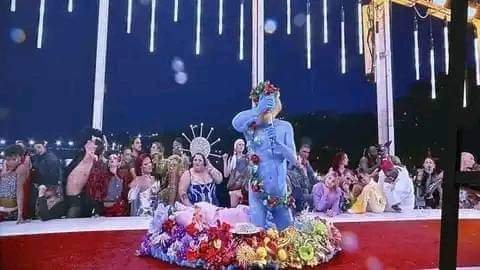By Chukwuyem Othniel Omijie (PhD)
A scene in the Paris 2024 Olympic Opening Ceremony provoked a global outrage on Friday July 26th, 2024, with Christians, church leaders and conservative politicians, calling it a mockery of the Last Supper. According to those condemning the depiction, was it really a likeness to Leonardo da Vinci’s biblical scene in The Last Supper or a re-enactment of the Dionysia festivals organized in honour of Dionysus, the Greek god of Wine?

To fully understand the issue at hand, we need to look at the nature and the origin of the Dionysia Festival. Dionysus is the Greek god of Wine and Fertility/Festivities, and the father of Sequana, the goddess of the Seine River. The Dionysia Festival is a grand pagan festival connected to the gods of Olympus, whose concept and practice have endured to the present day. The Dionysia festival originated from ancient Greek rituals to celebrate the end of Winter and the first grape harvest. It begins with a procession through the streets of Athens and involves a competition. The entertainment involved all the drinking and dancing expected of a festival of the iconic wine god. The Dionysia was known for its debauchery and ritual orgies. The Dionysia mystery was populated predominantly women. These women were known as Maenads, priestesses who lead processions. This explains the drag queens behind the blue man, symbolically, representing the Maenads and the blue man, the wine god himself! Lewdness was the order of the day for those complaining of the near-nakedness of the blue man
For those who are of the view that the central figure wearing the headdress was reminiscent of High-Renaissance-style Last Supper painting in which Jesus is depicted with a halo or light around his head, these symbols are connected to the Dionysia festivals and its Greek pagan worship affiliations. Moreover, there were at least 17 drag queens and more when the blue painted man sang, compared to Jesus’s Twelve Apostles. Referencing the Last Supper would have shown the apostles clustering in three groups of four connected through gestures that they make toward one another. According to Dr Marshall, an honorary senior lecturer at the University of Sidney and an expert in Renaissance art, “that is basic. You kind of have to have that number.”
It scene has no connection with the Last Supper, unless to the subjective mind. It is irrational and grossly subjective to link the Paris Olympic Opening Ceremony to the Last Supper, considering the number and gender of the apostles.
On a final and an unrelated note, I find it ridiculous to believe that Christians who readily accept the co-opting and absorption of the raucous pagan holiday of Saturnalia, as the birth of our Lord Jesus Christ (Pope Julius 1, chose December 25 to adopt and absorb the traditions of the pagan Saturnalia festival. It was first called the Feast of Nativity, the custom spread to Egypt by 432 and to England by the end of the Sixth Century), will complain of the depiction of Dionysia, linking it to the Last Super. We must at this point, understand the symbols and pagan practices associated with Dionysus, the Greek god of wine, and the fact that these symbols and practices predate Christianity as a religion. The organizers of the Olympic Games, owe no one any apology, as any accusation is as a result of religious misconception and historical ignorance on the part of religious extremists!



















